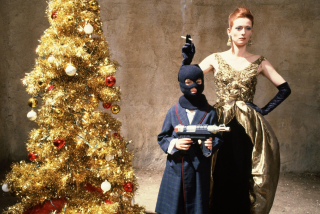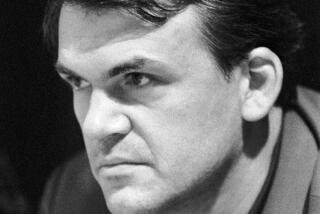Familiar Tales With New Twists
- Share via
Hanif Kureishi’s previous novels and movies have been accurate and inventive on the theme of a distant time and place, the London of the early 1980s.
Picking up his latest collection of short stories, I wondered whether that eyesight had remained acute with the passage of the years. So much time has passed since Kureishi’s “My Beautiful Laundrette,” “Sammy and Rosie Get Laid” and the superb novel “The Buddha of Suburbia” marked him as a writer with Renaissance talent and Rabelaisian energy.
Some of the stories in “Love in a Blue Time” go back to that era. “With Your Tongue Down My Throat,” a tale of two stepsisters, one brought up in Pakistan, the other in a London of government housing and abortion and the dole, dates back to 1987. It is vintage Kureishi with a polyglottal poetry of the urban zoo.
“We’re Not Jews,” like “The Buddha of Suburbia,” is narrated by a Kureishi stand-in, a half-Pakistani boy trying to make sense of the bullying his white mother receives on a bus ride of terror and shame.
And in the eyes of Lisa in “Blue, Blue Pictures of You,” London “was full of drugged, useless people who didn’t listen to one another but merely thought all the time of how to distract themselves and never spoke of anything serious.”
But the three new stories that conclude the collection jolt the reader into an entirely new place. The new place is not so much London in the ‘90s as it is Kureishi in the ‘90s, Kureishi in his 40s.
The stories are still full of the familiar speedball of sex and drugs and rock ‘n’ dole. But each declares itself to be motivated by the work of a great writer from the past. “Nightlight,” about a man’s weekly sexual liaison, opens with a quotation from Robert Louis Stevenson. “Lately,” the chronicle of a disenchanted colony of Englishmen at the seaside, acknowledges its debt to Anton Chekhov’s story “The Duel.” And the final story, “The Flies,” while quoting Italo Calvino at the top, owes more to Franz Kafka for its tone of bourgeois bewilderment in the face of horror than for its use of the insect kingdom.
In these stories, Kureishi experiments with style, moving out of his Blue Period toward something new. There’s something ungainly about the transition, something self-conscious about the homages to writers who have been homaged to death. Still, there’s a quirky nobility to the attempt. Kureishi is trying something we hadn’t expected to see on his program.
Why would a writer who has had such popular success in the triple crown of theater, film and literature engage in the potentially damaging business of retraining?
A clue may lie in the title story. “Love in a Blue Time” finds Kureishi, here called “Roy,” a wildly successful video director who “had lived through an age when men and women with energy and ruthlessness but without much ability or persistence excelled.”
Roy yearns to rise above this age. He is writing a movie, striving to educate himself, rising “at five in the morning to suck the essential vitamin of poetry” from the films of Bergman, Fellini, Ozu and Wilder. On the cusp of Hollywood and fatherhood, and against all judgment, he is called off to rescue Jimmy, an old pal, who has spent the last 20 years charging ruinously in the opposite direction.
Why? “The problem was that at the back of Roy’s world-view lay the Rolling Stones, and the delinquent dream of his adolescence--the idea that vigor and spirit existed in excess, authenticity and the romantic unleashed self: a bourgeois idea that was strictly anti-bourgeois.”
But Roy, like Kureishi, is no Keith Richards. Kureishi’s early success was the success of someone who could jump out of the maelstrom, of a Balzac, painting the anti-bourgeois for the bourgeoisie. Like Roy, Kureishi is telling us that he is going back to school, rethinking his style.
“Life,” as Roy says, “had become like a party at the end of the world. He was sick of it, as one may grow sick of champagne or of kicking a dead body. . . . If there was to be anything it had to be made anew.”
No more videos, Fellini next time.
More to Read
Sign up for our Book Club newsletter
Get the latest news, events and more from the Los Angeles Times Book Club, and help us get L.A. reading and talking.
You may occasionally receive promotional content from the Los Angeles Times.










